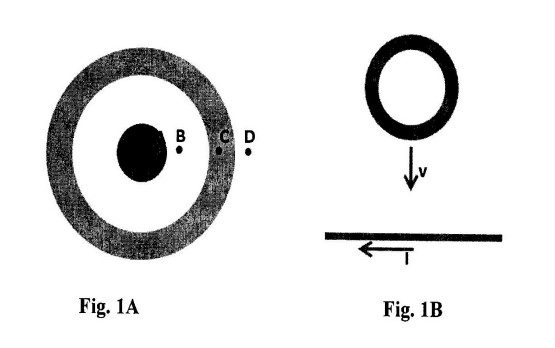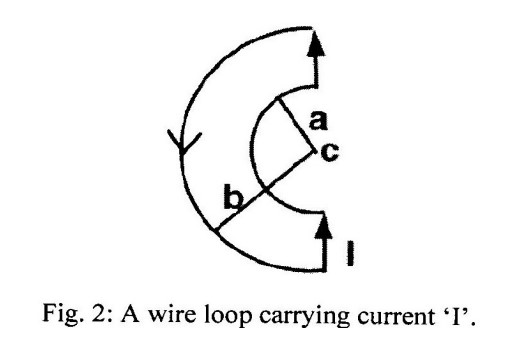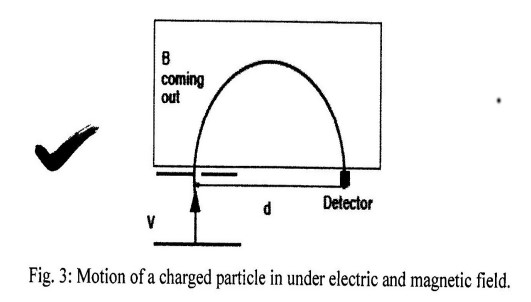PHY 102: End-semester examination
- (i)~A solid insulating sphere of radius 5 cm. carries electric charge uniformly distributed throughout its volume. Concentric with the sphere there is a conducting spherical shell with no net charge (Fig. 1A). The inner and outer radius of the shell is 10 cm and 15 cm., respectively. No other charge is nearby. Rank the magnitude of the electric field at points A,B,C and D. Give a physical explanation. (ii).~The potential energy of a pair of charged particle with the same sign is positive, whereas the potential energy of a pair of charged particles with opposite signs is negative. Give a physical explanation. (iii)~Fig. 1B shows a circular loop of wire falling toward a wire carrying a current I to the left. What is the direction of the induced current in the loop of wire? Give a physical explanation.(iv)~A polarizer for microwaves can be made as a grid of parallel metal wires approximately 1 cm. apart. Comment on the direction of the electric field vector for microwaves transmitted through this polarizer. (v)~Holding your hand at arm's length, you can readily block sunlight from reaching your eyes. Why can you not block sound from reaching you ears this way?

- (i)~Light of wavelength 480 nm in air falls on two slits 6.00\times10^{-2}mm apart. The apparatus, having viewing screen 40.0 cm away from slits, is immersed in water, (and water fills the intervening space). How far apart are the fringes on the screen?\hfill{\textbf{[5]}}\\ (ii)~find the resultant electric field and intensity of the superposition of two electromagnetic waves whose electric fields at a given location vary with time as follows: \vec{\pmb E}_1=3A_0\cos(kz-\omega t)\hat{\pmb i} and \vec{E}_2=5A_0\cos\left(kz-\omega t +{3\pi\over 2}\right)\hat{\pmb i}.\hfill{\textbf{[5]}}\\ (iii)~Describe amplitude, wave direction and the state of polarization (linear/circular/elliptical) of each of the following waves: ~~~~~(a)~\vec{\pmb E}=2E_0\cos(kz-\omega t)\hat{i}; ~~~~~(b)~\vec{\pmb E}=5E_0[\cos(kz-\omega t)\hat{i}+\sin(kz-\omega t)]\hfill{\textbf{[5]}}\\ \begin{center} \textbf{OR} \end{center} (iv)~ When a liquid is introduced into the air space between the lens and the plate in a Newton's string apparatus, the diameter of the tenth ring changes from 1.50 to 1.31 cm. Find the index of refraction of the liquid.
- (i)~Which of the following media may be treated as conducting at 8~MHz?\hfill{\textbf{[7]}} ~~~~~(a)~Wet marshy soil (\epsilon=15 \epsilon_0, \mu=\mu_0, \sigma=10^{-2}S/m) ~~~~~(b)~Intrinsic germanium (\epsilon=16 \epsilon_0, \mu=\mu_0, \sigma=0.025 S/m) ~~~~~(c)~Sea water (\epsilon=81 \epsilon_0, \mu=\mu_0, \sigma=25 S/m) (ii)~A grating with 250 grooves/mm is used with an incandescent lamp light source. Assume the visible spectrum to range in wavelength from 400 nm to 700 nm. In how many orders one can see (a)~the entire visible spectrum and ~(b)~the short wavelength region.
- A conductor in the shape of a long solid cylinder that has a length L, a radius a, and a conductivity \sigma carries a steady current I that is uniformly distributed over its cross-section. (a)~Use Ohm's law to relate the electric field \vec{\pmb E} in the conductor to I, \sigma, and a. (b)~Find the magnetic field \vec{\pmb B} just outside the conductor. (c)~Use the result from Part (a) and Part (b) to compute the Poynting vector \vec{\pmb S} at r=a (the edge of the conductor). In what direction is \vec{\pmb S}? (d) Find the flux \int\vec{\pmb S}\cdot {\pmb b}\vec{\pmb A} through the surface of the cylinder, and use this flux to show that the rate of energy flow into the conductor equal I^2R, where R is the resistance of the cylinder.\hfill{\textbf{[2+2+3+3]}}
- (i)~Find the energy stored in a uniformly charged solid sphere of radius R having total charge q.\hfill{\textbf{[5]}}\\ (ii)~Find the magnetic field at the center of the loop carrying a current I (2 Amp.) and made of two concentric semicircles of radii a (1 meter) and b (2 meter) and two straight segments along the diameter as shown in Fig. 2.
 (iii)~Particles of charge q and mass m are accelerated from rest by a voltage V (between two parallel plates) and enter a region of uniform B coming out of the page as shown in Fig. 3. They hit a detector after traveling a semicircle of diameter d. Find d in terms of the given parameters.
(iii)~Particles of charge q and mass m are accelerated from rest by a voltage V (between two parallel plates) and enter a region of uniform B coming out of the page as shown in Fig. 3. They hit a detector after traveling a semicircle of diameter d. Find d in terms of the given parameters.
\begin{array} \epsilon_0=8.85\times10^{-12}C^2/Nm^2; & [Permittivity of free space]\\ \mu_0=4\pi\times 10^{-7} N/A^2;& [Permeability of free space]\\ c=3\times10^8 m/sec;& [Speed of light]\\ e=1.6\times10^{-19}C;& [Charge of the electron]\\ m=9.11\times 10^{-31} kg; & [Mass of the electron]\\ n_{\rm glass}=1.5 ; & [Frefractive index of glass]\\ n_{\rm water}=1.33 ; & [Refractive index of water] \end{array}

Exclude node summary :
n
Exclude node links:
0
4727:Diamond Point
0






 ||Message]
||Message]
